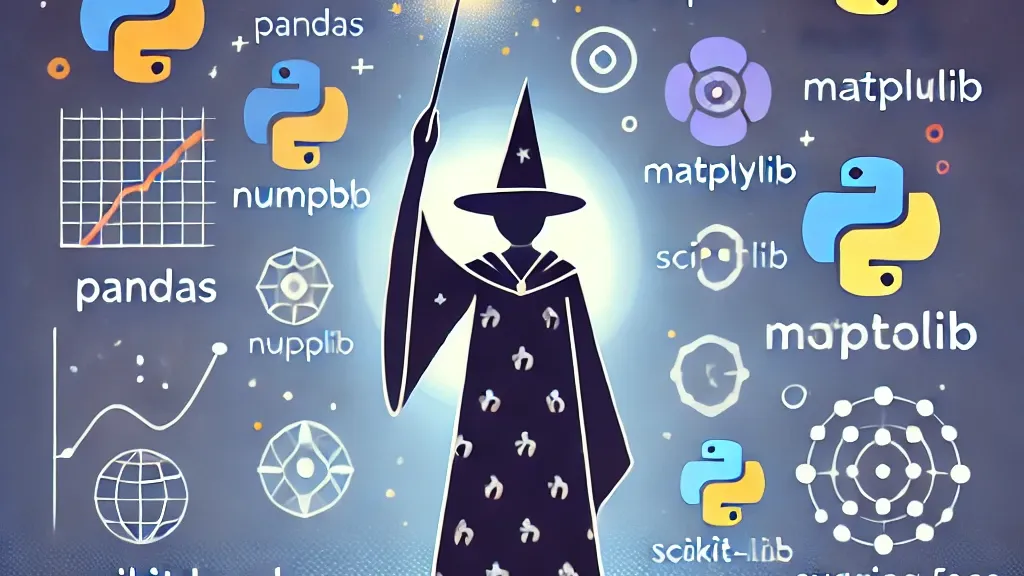
Introducing Libraries: Tools for AI Wizards
Ken Elwell
Technical Enablement & AI Content Strategy | Making AI & Security Understandable & Actionable
Unleashing the Power of Python Libraries
Python isn’t just a programming language—it’s a treasure trove of tools and libraries that make complex tasks easy, especially for AI enthusiasts. Think of libraries as the wands in an AI wizard’s toolkit—each designed to cast a specific spell, whether it’s handling data, running computations, or building machine learning models.
This article will introduce you to some essential Python libraries, focusing on their roles in AI workflows and how to use them effectively. By the end, you’ll be equipped to wield these tools like a pro.
The Magic of Python Libraries
Libraries are pre-written code modules that perform specific tasks. Instead of reinventing the wheel, you can import a library and focus on solving your problem. For AI workflows, libraries streamline processes, from data preparation to building complex models.
Popular Libraries for AI:
- Pandas: For data manipulation and analysis.
- NumPy: For numerical computations and matrix operations.
- Matplotlib: For data visualization.
- Transformers (Hugging Face): For working with pre-trained AI models.
- Scikit-learn: For machine learning algorithms and tools.
Library Highlights
1. Pandas: Taming the Data Jungle
What it Does: Pandas simplifies data manipulation with powerful data structures like DataFrames, which allow you to work with tabular data easily.
Example:
import pandas as pd
# Create a DataFrame
data = {'Name': ['Alice', 'Bob'], 'Age': [25, 30]}
df = pd.DataFrame(data)
# View data
print(df.head())
Why it Matters: For AI workflows, Pandas helps you clean, filter, and preprocess datasets before analysis.
2. NumPy: The Math Wizard
What it Does: NumPy provides fast and efficient tools for numerical computations, especially when working with large arrays and matrices.
Example:
import numpy as np
# Create an array
array = np.array([1, 2, 3, 4])
# Perform operations
print(array * 2)
Why it Matters: Many AI models rely on matrix operations, and NumPy ensures these computations are performed quickly.
3. Matplotlib: Painting Data Stories
What it Does: Matplotlib allows you to create a wide range of visualizations, from simple line plots to intricate heatmaps.
Example:
import matplotlib.pyplot as plt
# Plot a graph
plt.plot([1, 2, 3], [4, 5, 6])
plt.title("Simple Plot")
plt.show()
Why it Matters: Visualizations help you understand your data and communicate findings effectively.
4. Transformers: Bringing AI Models to Life
What it Does: Hugging Face’s Transformers library provides pre-trained models for tasks like text generation, summarization, and translation.
Example:
from transformers import pipeline
# Summarization
summarizer = pipeline("summarization")
print(summarizer("Artificial intelligence is revolutionizing the world of technology."))
Why it Matters: Transformers simplify access to state-of-the-art AI models without needing extensive resources or expertise.
领英推è
5. Scikit-learn: The Machine Learning Workhorse
What it Does: Scikit-learn is a versatile library for implementing machine learning algorithms, such as regression, classification, and clustering.
Example:
from sklearn.linear_model import LinearRegression
# Create and train a model
model = LinearRegression()
model.fit([[1], [2], [3]], [1, 2, 3])
# Predict
print(model.predict([[4]]))
Why it Matters: It’s the go-to library for building and testing machine learning models quickly.
How Libraries Work Together in AI
Libraries often complement each other. For example:
- Pandas prepares the data.
- NumPy performs numerical transformations.
- Scikit-learn builds and evaluates models.
- Matplotlib visualizes results.
- Transformers adds natural language processing capabilities.
This modular approach allows you to construct complex workflows efficiently.
Practical Exercise: Build a Simple Workflow
Combine libraries to process data, build a model, and visualize results.
Example:
import pandas as pd
import numpy as np
from sklearn.linear_model import LinearRegression
import matplotlib.pyplot as plt
# Create data
data = {'x': [1, 2, 3, 4], 'y': [2, 4, 6, 8]}
df = pd.DataFrame(data)
# Train model
model = LinearRegression()
model.fit(df[['x']], df['y'])
# Predict
predictions = model.predict(df[['x']])
# Plot results
plt.scatter(df['x'], df['y'], label="Actual")
plt.plot(df['x'], predictions, label="Predicted", color="red")
plt.legend()
plt.show()
Why This Matters for TicTec
Python libraries are essential for the Local RAG project. Whether you’re cleaning data with Pandas or integrating Hugging Face models, these tools empower you to focus on creativity and problem-solving instead of repetitive tasks.
What’s Next?
Tomorrow’s article will dive deeper into writing modular Python code, emphasizing reusability and best practices. By the end of the week, you’ll not only know the tools but also how to wield them effectively in your AI workflows.
Tags
#TicTec #PythonLibraries #AIWorkflows #LearnPython #DataScience #HuggingFace #MachineLearning
Explore More from Lo-Fi AI
?? Full Discography: Discover all tracks and volumes of the Lo-Fi AI series.
?? Project Repository: Access prompts, resources, and related materials for Lo-Fi AI projects.
Senior Managing Director
2 个月Ken Elwell Fascinating read. Thank you for sharing
Helping SMEs automate and scale their operations with seamless tools, while sharing my journey in system automation and entrepreneurship
2 个月It’s inspiring to see a focus on getting started with AI using simple libraries and methods. Small changes in learning can lead to big improvements in skills. ?? What is one easy tip you’d give to a beginner starting out with AI techniques?
Tech Company Co-Founder & COO | Talking about Innovations for the Logistics Industry | AI & Cloud Solutions | Custom Software Development
2 个月Ken Elwell, strategic python libraries not only enhance ai capabilities but also streamline development paths for groundbreaking innovations. ??